Last week, we looked at these beautiful copper sheet stencils that were used back in the day to transfer initials to household items for embroidering.
I played around with some ready-at-hand transfer mediums (also known as pens and pencils!) that I thought might work with the stencils. Today, I’ll show you those, including the one I settled on that worked well for transferring the letters in preparation for some simple embroidery.
I still want to fiddle about with other transfer ideas. There are two in particular I’d like to experiment with, but I haven’t gotten around to pulling out the mess yet!
In the meantime, though, here’s what I did with the stencils and some pens and pencils.
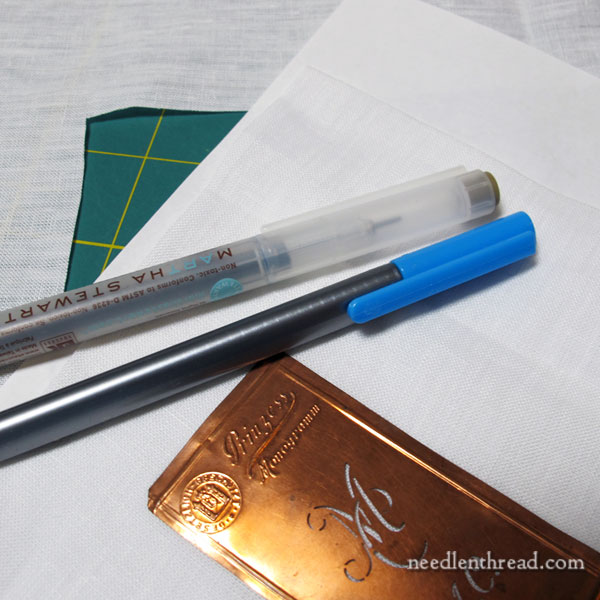
I started with two different pens.
One is a Martha Steward archival and permanent drawing pen, with a tiny tip, in the color “moonstone.” I’ve used this pen in the past to trace many, many (many!) projects onto linen. (I used it, for example, on the Hungarian Redwork Runner.)
It’s a subtle, grayish taupe color, and it makes a nice, tiny crisp line that is permanent, so the line has to be covered all the way when you’re embroidering it. But, because it’s a fairly subtle color, it just works well.
I love these pens, but they don’t make them anymore, to my knowledge. If you can find them, they’re only available in whole pen sets that are mighty pricy when you just want the one pen!
The other pen is a Staedtler Triplus Fineliner Marker. I use these pens for sketching, coloring, design doodling, and note-taking on paper and in a sketch book. I like them because they’re comfortable to hold, they have a tiny tip, and they don’t tend to bleed on paper.
The Staedtler pens are a water-based ink, and according to the manufacturer, the ink washes out of “many” textiles.
I haven’t tested its washing-out capabilities, so if you’re going to try a pen like this for tracing embroidery designs in the hopes of its washing out, please do test it first on the same type of ground fabric you plan to use!
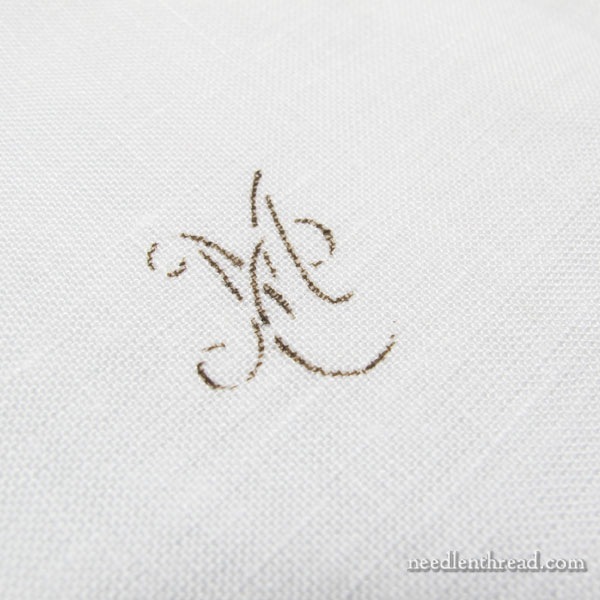
Here’s the moonstone Martha Stewart pen result.
The color isn’t too subtle here, because I ended up going over the stencil several times with it. The more I went over it, the darker the lines.
With just one pass on the stencil, the stencil marking wasn’t clear enough. The edges didn’t pick up crisply.
I’d say this is a no, overall. The transfer, though crisp enough, is just too dark for my preferences. I suppose if you were using a dark thread and covering the lines completely with embroidery, it would be ok.
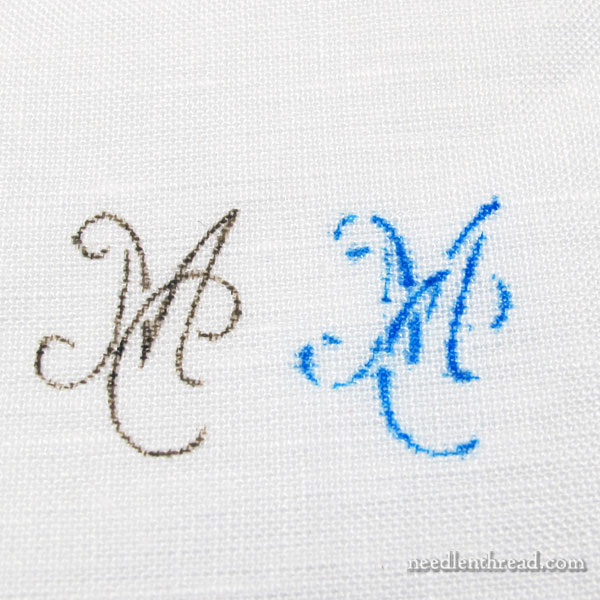
And while the Staedtler pen doesn’t bleed on the paper in my sketch book, on this particular linen, it was a Whole Nuther Question!
Too much bleeding! This one is clearly a no, even if the ink washes out of this particular textile.
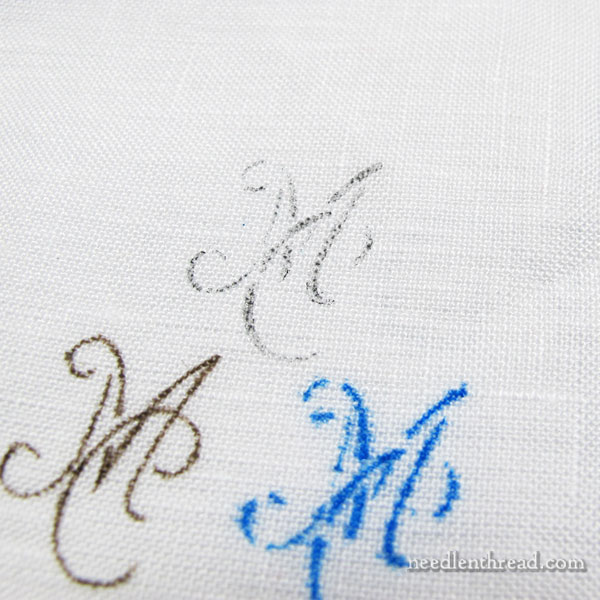
Next up – in the hazy MC above the two already tested – I tried a 3B drawing pencil, going over the stencil in a sketchy way just once.
You know, overall, that’s not a bad transfer. On a piece of spray starched linen (I talk about using spray starch and pencil in this article), the pencil would wash out. It’s a decent, clear line.
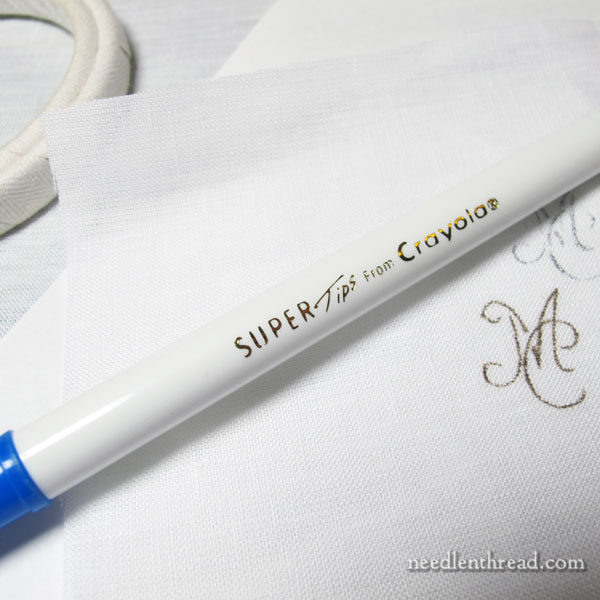
Then I remembered these Crayola markers, which a reader had recommended quite a while ago as being washable and making a good transfer instrument.
I tried them once in a regularly traced transfer, but the lines were very thick and very dark and just didn’t work well for me. I also had a hard time cleaning them out of the fabric without a thoroughly long soapy soak, and even then, there was a little residual ghosting of the ink.
But I figured the thicker tip might work well in a stencil application, so why not try it?
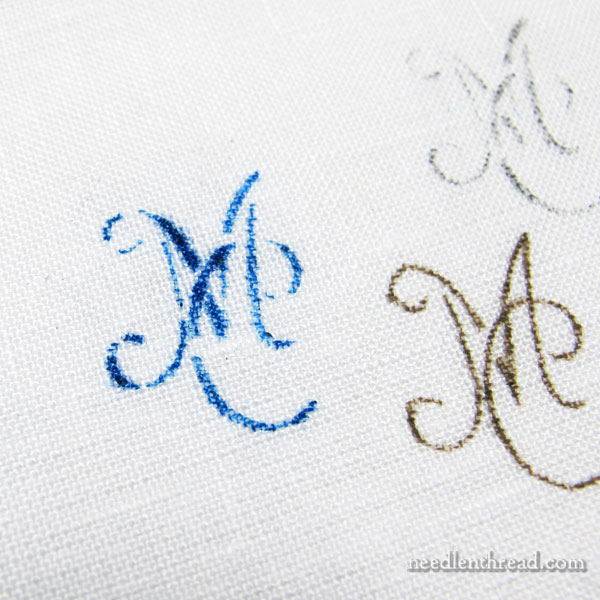
It certainly gets the letters on, but again, too dark and quite a bit of bleeding.
I’d say it’s pretty much a big fat furry no, for an embroidery transfer.
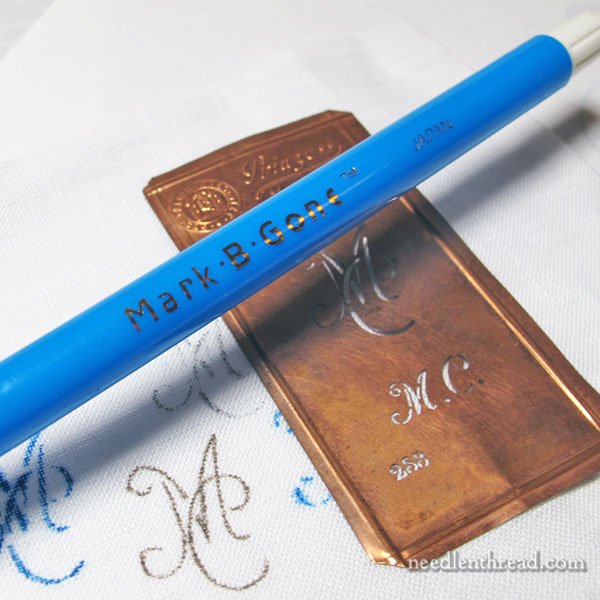
Then I thought I’d take a page out of Jen’s book and try the ubiquitous water-soluble blue pen.
This was the only one I had on hand.
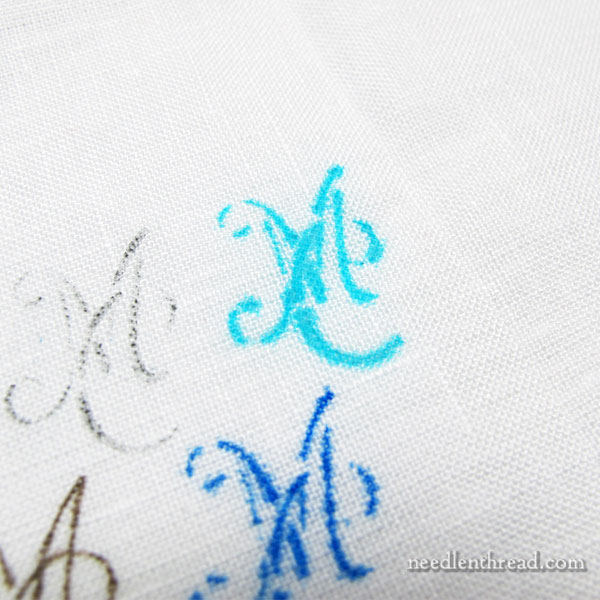
While the method worked for Jen, it didn’t really work well for me. It could be a difference in the pen, in the fabric, in our respective “touch” when applying the pen.
Whatever the case, the transfer, though clearly visible, isn’t crisp enough. It really spread a lot, making the lines of the monogram quite pudgy.
See, I like a really crisp line when I’m transferring something. The crisper the line, the more accurate my embroidery.
So this one just didn’t do it for me.
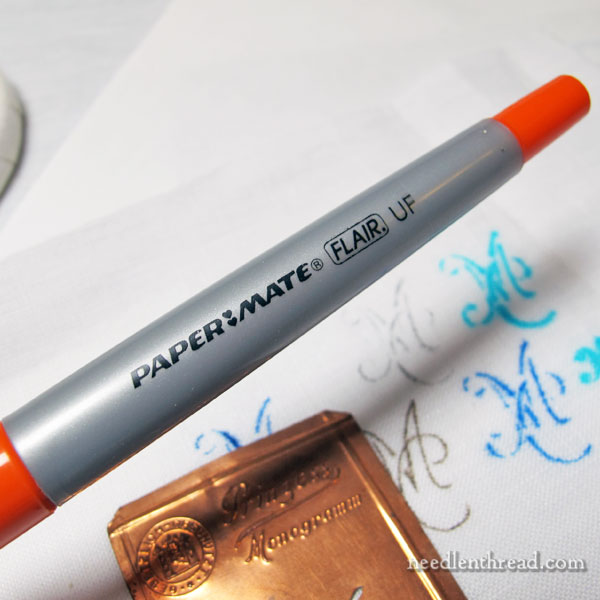
Many readers have asked me over the years about the Papermate Flair pens.
I know some folks swear by them for embroidery transfers. They draw a very dark, clean line (a little heavy, but not “thick”) and they wash out of fabric.
I’ve written about these pens before, here, where I experimented with them.
Well, why not? I tried one on the stencil.
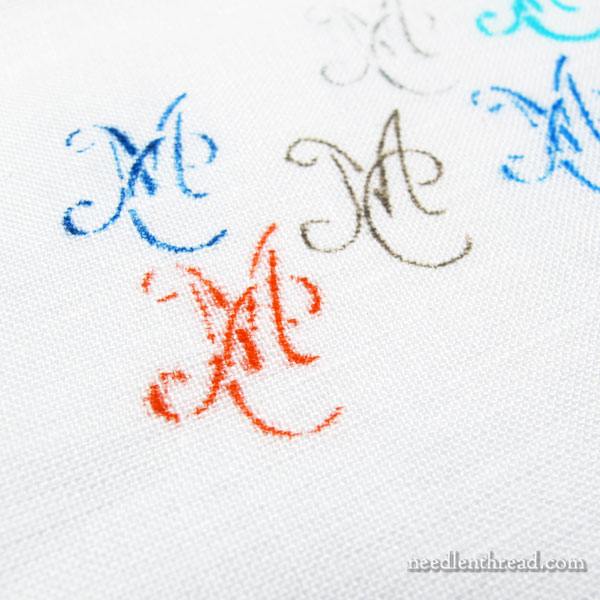
The design is certainly clear, and the ink went on easily enough. I didn’t have to sketch or go over the stencil again.
There is, however, a bit too much of a bleed going on, I think.
Now, the bleed may be different on other fabric. I only tested these on a lightweight linen, since that’s pretty much what I’d use these types of stencil monograms for.
On fabrics with a tighter, denser weave and a smooth hand (for example, a high count cotton or a heavier weight, higher thread count linen), you might not get the same level of bleed.
In any case, again, I’d chalk this one up as a no, and not just because of the darkness of the line and the bleed, but also because these pens don’t necessarily always perform as anticipated.
I’ve heard from several stitchers who have had problems getting the ink to wash out after it’s been on the fabric a while. If you’re quick with your stitching and the project can be washed thoroughly, the ink comes out ok, though it can be a little shocking at first when the water hits it and it runs its bright colors everywhere. Eventually, the color washes out.
But the longer a project sits, the harder it is to get the ink out.
I’d skip this one, personally.
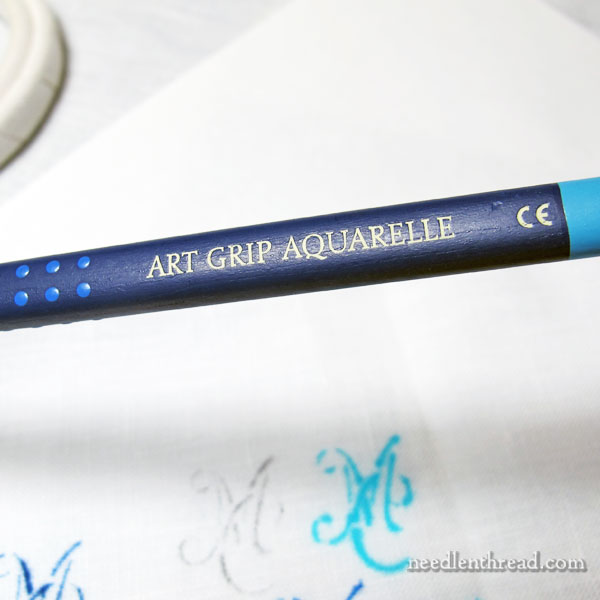
Back to pencils!
Faber-Castell makes these Aquarelle watercolor pencils that I bought in several colors of blue, individually, from an art store a few years back.
In fact, they’re not my favorite watercolor pencils. I use these Derwent watercolor pencils pretty regularly for designing and doodling up ideas, but the Aquarelle are fairly decent when it comes to drawing a fine blue design line on linen.
The advantage of using blue when transferring a monogram – especially on white that’s going to be stitched with white thread – is that, even if the blue doesn’t wash completely out (and these pretty much do, with enough soaking), anything that remains isn’t really noticeable. Faint blue tends to absorb into white, making white seem brighter.
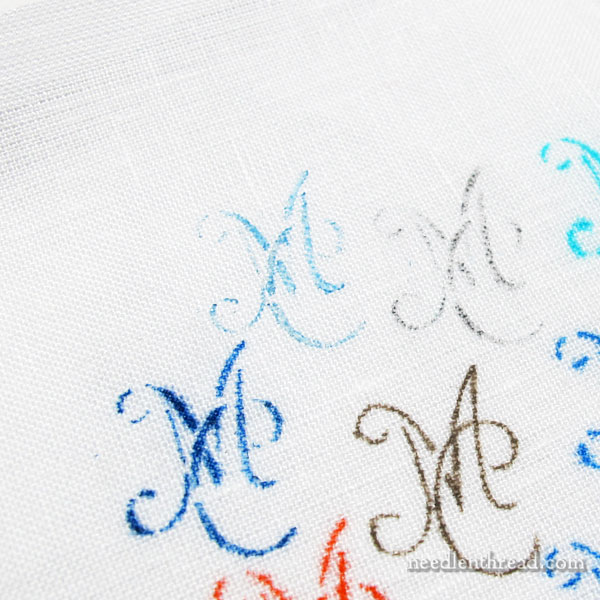
This is the pencil result, to the top right of the very dark blue monogram.
Now, that’s a transfer I can get behind! I had to sketch a bit with the pencil, to get it to fill in the whole stencil well, but it came out sharp and neat, easy to see, but not so dark as to be disturbing.
At this point, satisfied that the blue pencil would work pretty well, I put away the rest of the pens and pencils, and concentrated on making a decent monogram transfer with the blue Aquarelle pencil.
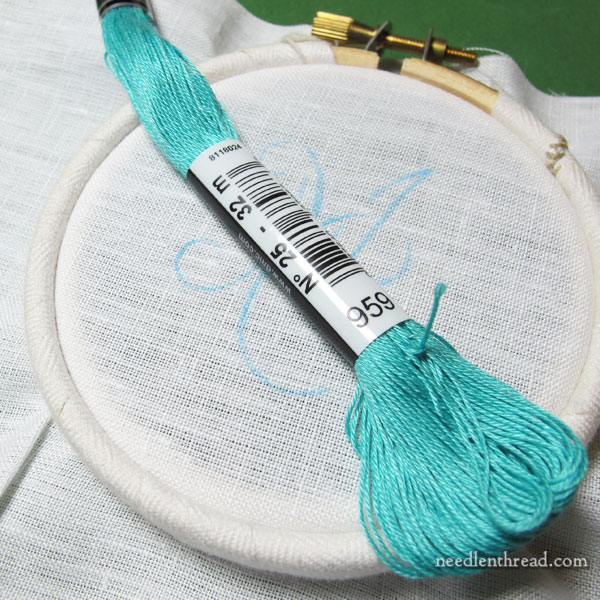
For the stitched sample, I’m using the larger of the monogram stencils, transferred onto a handkerchief weight linen, using the blue Aquarelle pencil, hooped up in a 3″ inch hoop (that’s bound with twill tape in this manner), and this aqua coton a border #25.
I’ll be stitching with a #7 crewel needle. And down the road, I’ll show you the simple approach I took to working this particular quick monogram, using one simple stitch to cover both the broad and narrow strokes of the letters.
And that, my friends, is the extent of my stencil transfer explorations for now. I plan to try a couple other options – neither pen nor pencil! – in the future.
Before I get back to that, though, there are some more pressing projects just dying for my attention!






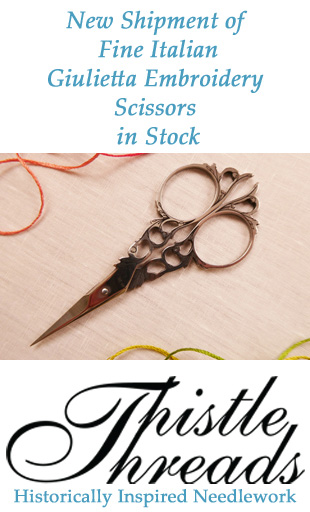
Mary Have you tried friction (frixion) pens -they come in a variety of colours – inc. red and green as well as standard black and blue. They give a very fine line so may need several goes – but they disappear with heat or friction so a light iron can get rid of the marks. May be worth trying as they are relatively cheap in UK at least.
Hi, Ann – yes, I have! I’ve written about them and why I don’t use them, here: https://needlenthread.wpengine.com/2014/09/embroidery-design-transfer-question-frixion-pens.html
Thanks, Mary for testing all of these pencils and markers. You have used the Pilot Eno before and was wondering why you didn’t test this marker.
Hi, Wendi – the Eno is a pencil with removable leads. They are relatively fine, but a little rounded, and a tad bit waxy, which makes them difficult to use with the fine cut of the stencils.
Dear Mary
A great experiment for testing different pens to transfer patterns, its interesting to see how the pens work and differ on fabric. As you say its always good to test pens first before transferring to the fabric. I like the size options on the stencils and the design is lovely, the thread colour you have chosen is also lovely, I look forward to the progress on this and to more experiments with the stencils. Thanks for sharing your experiments with pencils and stencils with us and for the photos.
Regards Anita Simmance
Hi Mary,
Very interesting and helpful article! I’ve been wondering about the most reliable pen or pencil for drawing on cloth. I reveal my newness to all of this in asking if anyone ever draws freehand directly onto the fabric. Would the result simply be too irregular even if one could draw well enough for the embroidery to look neat and uniform? I suspect there are several very good reasons for not taking this approach, but I actually don’t know being so completely new to this beautiful art form.
Cheers,
Mike
Mary, Have you tried actually using a watercolor brush and your Derwent pencils to use the stencil? I’d love to hear if you have.
Derwent Inktense is an ink pencil that is water soluble when applied, but dries permanent. I’m not interested in washing the marks out, if they are covered by the stitching they don’t matter.
I also like Micron pens. Archival, very fine point options, and come in a handful of colors.
Thanks to your recommendation last week to look on eBay, I received my copper stencils in the mail this weekend. I was surprised at how fine the openings were and didn’t have as many options to try out as you did. But I ended up using a very fine tip pencil to get in the slits, and drew the monogram onto a piece of paper. Then I photocopied that slightly larger so I could trace over the monogram using my light box. Afterwards I realized I could have just photocopied the metal monogram, then use a dark pen to outline the monogram, for tracing. Either way, I love them, and thank you for the ideas!
In almost all cases, I use the Pigma Micron pens by Sakura, 01 or 03. I also had an 005 but I think it wore out-I no longer have it. They come in a variety of colors although I mostly use the black. As far as I know, they are permanent and do not bleed if dampened. I do mostly canvas work but I have tried them on cotton fabric. Sharpie also makes an “ultra fine point permanent marker” that looks like 03 or 05. It says on the pen it is not for cloth but it seems to work OK and not bleed. These also come in a variety of colors. JoyceAnne
I can see why you like those Martha Stewart pens. Super crisp compared to the rest of them.
Try writing to Martha and explain why you like those pens? With enough write ins they may do a limited run of new ones, or send you some other ‘current’ pen to try. Wouldn’t hurt to try.
This was such a fun read! I used a fine-tipped aqua trick marker and it worked really well. However, I think I used it in a different was as I put the tip in the stencil void and ‘filled it out’. Can’t wait to see your other tests!
Finding a good transfer pen is always a challenge. I’ve had enough pens bleed their ink into my thread when I wash it, that I always go for something permanent now. Sakura Gelly Roll pens have served me pretty well. They aren’t as fine as some others, but they don’t bleed, don’t wash out or run, and work on many different types of fabric. There is even a white pen that works well on dark fabrics.
Dear Mary,
My question is: You have previously wet the pencil, before applying it on the fabric. Or you’ve done it dry?
Thank you very much and best regards!
Sincereally, Paula.